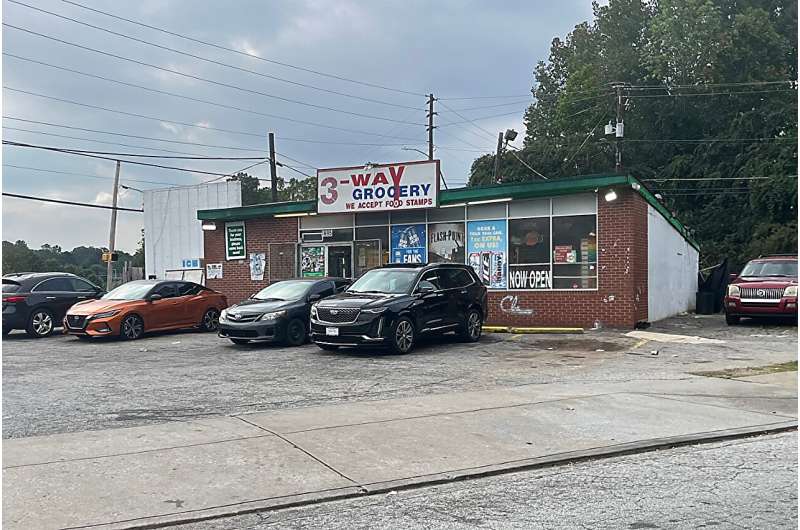This article has been reviewed according to Science X's editorial process and policies. Editors have highlighted the following attributes while ensuring the content's credibility:
fact-checked
trusted source
proofread
Report shows majority-Black, low-income neighborhoods have less access to fresh produce

Residents of Atlanta's majority-Black and low-income neighborhoods have significantly less access to fresh produce than residents of the city's non-majority-Black and higher income neighborhoods, according to a new surveillance report released Tuesday by researchers at Emory University's Rollins School of Public Health.
Key findings:
- Small food stores are abundant in Atlanta, with higher concentrations in majority-Black and low-income, low-supermarket-access neighborhoods.
- Less than half (44%) of the 150 randomly selected small food stores in Atlanta offered fresh produce.
- Stark disparities in produce availability existed in majority-Black and low-income neighborhoods.
The report provides measurable evidence illustrating the ongoing effects that both economic inequality and structural racism play in Atlanta and how this manifests in a lack of access to foods that promote health and well-being.
Why fresh produce access matters
- The Dietary Guidelines for Americans 2020–2025 recommends fresh fruit and vegetable intake as part of a healthy dietary pattern to promote health, reduce the risk of chronic disease, and meet nutrient needs. However, a key barrier to fruit and vegetable intake is having limited access to fresh produce.
- These barriers tend to disproportionately impact low-income neighborhoods and communities of color where fewer grocery stores exist, and convenience stores are abundant.
- The City of Atlanta has recently made substantial progress in expanding fresh food access to meet the goal of ensuring at least 85% of Atlanta residents live within a half-mile of fresh affordable food by 2022. According to the City of Atlanta Fresh Food Access 2020 report, 75% of the city's residents lived within a half-mile of fresh produce in 2020 compared to 52% in 2015. However, this progress was achieved unevenly across the city, as improved access occurred primarily in neighborhoods with higher proportions of White residents.
What can be done
The Emory researchers offer several recommendations to help address the access inequity, including:
- Tax incentives: Local and State governments could consider offering tax exemptions or other incentive-based tax structures to independently-and/or minority-owned small food retailers who carry fresh produce and produce distributors capable of supplying corner stores with small orders as well as on-the-go fresh produce snacks that align healthier options with the convenience store business model.
- Require dollar stores to carry fresh fruits and vegetables: This project found that while dollar stores were more prevalent in low-income and majority-Black neighborhoods, none carried fresh produce.
- Update SNAP retailer requirements: The high proportion of the Supplemental Nutrition Assistance Program (SNAP) retailers in Atlanta's majority-Black neighborhoods that did not carry fresh produce highlights the need for the U.S. Department of Agriculture's current SNAP program to add a fresh produce requirement.
Megan Winkler, Ph.D., assistant professor in the Department of Behavioral, Social, and Health Education Sciences at Emory's Rollins School of Public Health, states, "These small food stores—such as corner stores, convenience stores and dollar stores—are more common in low-income and majority-Black neighborhoods, and we found very stark access disparities in the fresh produce offered among those stores.
"This is a long-standing issue, and it is not an only-in-Atlanta issue, we have seen these patterns elsewhere. What is most important for folks to understand is that there are things that we can do about it. There are so many places of opportunity to really leverage change."
Angela Zhang, MPH, public health program associate in the Department of Behavioral, Social, and Health Education Sciences at Emory's Rollins School of Public Health, says, "This is such a complex, systemic problem that has existed for many years, there is no single solution that is going to fix the problem.
"But in Atlanta, we have a very concentrated population and there is an abundance of these small food stores that have a lot of potential for healthy food options that are not currently being explored enough. So, this is a unique opportunity for different stakeholders to come together to promote healthy eating in the city."




















